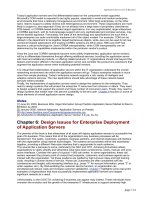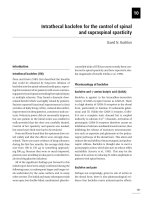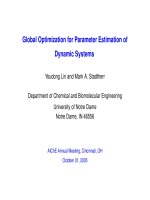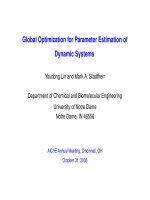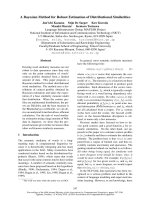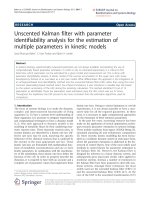Species specific allometric equations for biomass estimation of three selected trees species in egdu forest of oromia national regional state
Bạn đang xem bản rút gọn của tài liệu. Xem và tải ngay bản đầy đủ của tài liệu tại đây (1.59 MB, 72 trang )
ADDIS ABABA UNINVERSITY
COLLEGE OF NATURAL AND COMPUTATIONAL SCIENCE
CENTER FOR ENVIRONMENTAL SCIENCE
Species Specific Allometric Equations for Biomass
Estimation of Three Selected Trees Species in Egdu
Forest of OromiaNational Regional State
Tesfaye Debela
Addis Ababa, Ethiopia
June, 2017
ADDIS ABABA UNINVERSITY
COLLEGE OF NATURAL AND COMPUTATIONAL SCIENCE
CENTER FOR ENVIRONMENTAL SCIENCE
Species Specific Allometric Equations for Biomass
Estimation of Three Selected Trees Species in Egdu
Forest of Oromia National Regional State
A Thesis Submitted to Center for Environmental Science
In Partial Fulfillment of the Requirements for the Degree of
Master of Science (Environmental Science)
By
Tesfaye Debela
Advisor: Teshome Soromessa (Assoc. Professor)
Addis Ababa, Ethiopia
June, 2017
ADDIS ABABA UNINVERSITY
COLLEGE OF NATURAL AND COMPUTATIONAL SCIENCE
CENTER FOR ENVIRONMENTAL SCIENCE
This to certify that the thesis prepared by TesfayeDebela entitled: Species Specific
Allometric Equations for Biomass Estimation of Three Selected Trees Species in Egdu
Forest of Oromia National Regional StateImplication for Sustainable Management
and Climatic Change Mitigation and submitted in partial fulfillment of the requirements
for the Degree of Master of Science (Environmental Science) complies with the
regulation of the University and meets the accepted standards with the respect to
originality and quality.
Signed by examining committee:
Examiner ______________________ signature_______Date _________
Examiner ______________________ signature _______Date _________
Advisor _________________________signature ______Date__________
………………………………………………………………………………..
DEDICATION
This piece of work is dedicated to my sisters Alemitu Debela and Diribe Debela for
their endless love, nursing me from child stage, educating, supporting and
encouragingto my success though death come ahead of their revels a bit before my
success in joining of the University.
Tesfaye Debela Bedane ___________________________
Signature
Species Specific Allometric Equations for Biomass Estimation of Three Selected Trees
Species in Egdu Forest of Oromia National Regional State: Implication for Sustainable
Management and Climatic Change Mitigation
TesfayeDebela, MSc
Addis Ababa University, 2017
Abstract
Species specific allometric equations are important for accurate net aboveground
biomass estimation and quantifying carbon stock in living tree biomass of
terrestrial ecosystems. This study was undertaken to develop species-specific allometric
equation semi-destructively of two indigenousand one exotic tree species namely Mytenu
sobscura, Rosa abyssinica and Eucalyptus globulus respectively in Egdu forest of
Oromia Region. Currently, like that most Ethiopian forest such model did not exist for
this particular species by this methodology. The data was taken from 12 individuals
of each species with different DBH class intervals. Preferential sampling method was
used to collected data by DBH class. The allometric equations were developed by
relating tree component biomass to DBH or basal diameter. Four equations with
high adjusted R2adj&correlation and low AIC & RSE value were selected for each tree
species and the statistical analysis was highly significant (p<0.000) fit for linear
models for all species and displayed minimal bias. They had a mean total biomass of
118.24 kg, 43.54 kg and 1026.52 kg for Mytenus obscura, Rosa abyssinica and
Eucalyptus globules respectively. It is understood that previously published general
allometric model reveal errors of over estimation of biomass in higher DBH classes
and underestimation in lower DBH classes, and the formulated new equations will be
used in the future for the selected three tree species. And it would create an opportunities
for sustainable management of forest and to mitigate climatic change through
increasing the household income through better assessment of biomass and carbon
finance.
Key words: Allometric model, Biomass, species specific, Egdu forest, semi-destructive
method.
i
ACKNOWLEDGEMENTS
I would like to thanks the Almighty God who help and guide me in all aspect of my life
especially to accomplish this work successfully. Glory to the Almighty for his care and
smoothening challenges in doing this research.
I am very grateful to my advisor Dr. Teshome Soromessa and appreciation for his
unreserved support in guiding me through this research from its start to the end with
limitless help in giving valuable advice, constructive comments and a number of supports
for this thesis work. I am indebted to Addis Ababa Thematic Research fund through the
title “Biodiversity, Insect-Plant Interaction, Environmental Degradation Nexus: Towards
a Sustainable Development, Climate Change Mitigation & Adaptation in Eastern and
Southern Ethiopia”.
My special thanks also to my best friend Birhanu Kebede for his assistance in
statistical analyses, valuable
moral
support, encouragement, discussions and his
technicalhelp during field work and thesis write up were invaluable to me. His continuous
support, discussions and suggestion guided me to become self- reliant and efficient
during the work.
I would like to extend my appreciation to Egdu forest residents, administration staff of
the forest, and scientific staffs especially to Ato Shimelis Telila and Ato Urge Charu
(foresters) for their technical support and facilitating the field work and to Ato Gadisa
Hirphaye and Dechasa Bekele tree climbers and truthful assistance.
I express my honest and sincere gratitude towards my family for their encouragement to
pursue this study. Especially my brother Rabira Debela, though I cannot express my
thankfulness to them in words, I can say that it is only because of their love, support and
blessings that I gained the strength to complete this study successfully.
Finally, I would like to express my deepest thanks to my love, Bethelium Eshetu
and her family take the lion share of myheart-felt gratitude, because they have been
providing me their kindness’ and moral support in all walks of the thesis.
ii
List of Acronyms
AGB
Aboveground biomass
AIC
Akaike Information Criterion
B
Biomass
BasalD
Basal diameter
BGB
Belowground biomass
CDM
Clean Development Mechanism
CF
Correction factor
FAO
Food aid organization
DBH
Diameter at Breast Height (at 1.3m from ground)
GHG
Green House Gas
GLAFOLU
Guidelines for Agriculture, Forestry and Other Land Uses
GPS
Geographical Positioning System
IPCC
Intergovernmental Panel on Climate Change
MAMF
Menagesha Amba Mariam Forest
NAMA
National Appropriate Mitigation Action
REDD
Reducing Emissions from Deforestation and Forest Degradation
REDD+
Reducing Emissions from Deforestation and Forest
Degradation plus Biodiversity conservation, Sustainable
SD
Standard Deviation
TB
Total Biomass
UNEP
Unite Nations Environment Programme
UNFCCC
United Nations Framework Convention on Climate Change
WD
Wood density (g/cm3)
iii
Table of Contents
Page
Abstract ..................................................................................................................................................... i
ACKNOWLEDGEMENTS ............................................................................................................................ ii
List of Acronyms ...................................................................................................................................... iii
Table of Contents .................................................................................................................................... iv
List of Tables ............................................................................................................................................ vi
List of Figures.......................................................................................................................................... vii
1.
Introduction ......................................................................................................................................1
1.1. Background ....................................................................................................................................1
1.2. Allometry in Ethiopia .....................................................................................................................6
1.3. Statement of the Problem .............................................................................................................6
1.4. Objectives ......................................................................................................................................8
1.4.1. General Objective ...................................................................................................................8
1.4.2 Specific objectives ...................................................................................................................8
1.5. Organization of the Thesis .............................................................................................................8
2. REVIEW OF RELATED LITRATURE .........................................................................................................9
2.1. Overview of Global Climatic Change .............................................................................................9
2.2. Conventions and Negotiations of Climatic Change .....................................................................10
2.3. What is Allometric Equation? ......................................................................................................12
2.4. Benefits and Limitations of Existing Allometric Equation ...........................................................13
2.4.1. General Allometric Equation ................................................................................................13
2.4.2. Species- Specific Allometric Equation ..................................................................................14
2.5. Biomass Measurement ................................................................................................................14
2.5.1. Destructive Biomass Measurement .....................................................................................15
2.5.2. Non-Destructive Biomass Measurement .............................................................................16
2.6. Tree Biomass and Carbon Sequestration ....................................................................................16
2.7. GHGs Emission Inventory in Ethiopia ..........................................................................................18
2.8. Overview of Ethiopia Forest Biomass ..........................................................................................19
3. MATERIALS AND METHODOLOGY ......................................................................................................21
iv
3.1. Description of the study area ......................................................................................................21
3.1.1. Geographic location .............................................................................................................21
3.1.2. Climate..................................................................................................................................22
3.2 Description of the Species ............................................................................................................23
3.2.1 Eucalyptus globulus- Labill. - Myrtaceae ...............................................................................23
3.2.2 Maytenus obscura (A. Rich.) Cuf - Celastraceae ....................................................................23
3.2.3 Rosa abyssinica Lindley .........................................................................................................24
3.3 Methods .......................................................................................................................................25
3.3.1. Reconnaissance Survey ........................................................................................................25
3.3.2 Selecting Species and Trees...................................................................................................25
3.3.3 Variables Measurement and Calculation for Volume and Biomass ......................................26
3.3.4 Measuring trimmed fresh biomass .......................................................................................27
3.3.5 Measuring untrimmed fresh biomass ...................................................................................28
3.4 Data Analysis ................................................................................................................................32
4. RESULTS AND DISCUSTION .................................................................................................................33
4.1. Results .........................................................................................................................................33
4.1.1. Species Biomass....................................................................................................................33
4.2 Allometric Equations ....................................................................................................................34
4.3 Discussions ...................................................................................................................................42
4.3.1 Allometric Equation Comparison ..........................................................................................43
4.3.2 Allometric Equation and Carbon Finance ..............................................................................46
5. CONCLUSION AND RECOMMENDATIONS ..........................................................................................48
5.1. Conclusion ...................................................................................................................................48
5.2 Recommendations........................................................................................................................49
REFERENCES ...........................................................................................................................................50
Appendix.................................................................................................................................................59
v
List of Tables
Table 1: The mean, standard deviation, maximum and minimum of species........................37
Table 2: DBH class of Eucalyptus globulus, Maytenus obscura and Rosa abyssinica .........38
Table 3: Dendrometric variables with correlation coefficients for Mytenusobscura ............39
Table-4: Dendrometric variables with goodness-of-fit statistics for Mytenus obscura…… ...39
Table-5: Dendrometric variables with correlation coefficients for Rosa abyssinica…… .......40
Table-6: Dendrometric variables with goodness-of-fit statistics for Rosa abyssinica...........41
Table- 7: Dendrometric variables with correlation coefficients for Eucalyptus globulus .....41
Table-8: Dendrometric variables with goodness-of-fit statistics for Eucalyptus globulus ....42
Table 9: Expected carbon price for the 3 tree species (average tree biomass per ton) ..........49
vi
List of Figures
Figure 1: Location map of the study area........................................................................................... 22
Figure 2: Climate diagram of Egdu forest and the surrounding areas .............................................. 23
Figure 3– Determination of total fresh biomass. (A) Separation and measurement of trimmed
and untrimmed biomass, (B) numbering of the sections and branches measured on a trimmed
tree ..................................................................................................................................................... 28
Figure 4 – Measuring sample volume by water displacement........................................................... 43
Figure 5Relationship between AGB of Maytenus obscura and predictor variable DBH .................... 44
Figure 6 Relationship between AGB of Rosa abyssinica and predictor variable DBH ........................ 44
Figure 7 Relationship between AGB of Eucalyptus globulus and predictor variable DBH ................. 45
Figure 8.Allometric equation comparisons for Mytenus obscura AGB .............................................. 47
Figure 9.Allometric equation comparisons for Rosa abyssinica AGB................................................. 47
Figure 10.Allometric equation comparisons for Eucalyptus globulus AGB ..................................... 48
vii
1. Introduction
1.1. Background
Scientific measurements have shown that atmospheric concentration of greenhouse gases
(GHGs) has been increasing rapidly as a result of human activities such as fossil fuel
burning, deforestation and industrial emissions. It is believed that increased
concentrations of greenhouse gases will lead to global climate change. It is also widely
accepted that global climate change would have adverse impacts on socioeconomic
development of all nations (IPCC, 2007, Canadell and Raupach, 2008).
Because of interest in the global carbon (C) cycle, estimating above ground biomass with
sufficient accuracy to establish the increments or decrements of C stored in forests is
increasingly important. Forests form a major component of the C reserves in the world’s
ecosystems (Houghton, 2007) and greatly influence both the lives of other organisms and
human beings (Whittaker and Likens, 2005). Trees also play a key role in the global C
cycle. Managing forests through agroforestry, forestry and plantation systems is seen as
an important opportunity for climate change mitigation and adaptation (IPCC, 2007;
Canadell and Raupach, 2008).
Afforestation and reforestation (A/R) project activities are eligible under the Clean
Development Mechanism (CDM) of the Kyoto Protocol of the United Nations
Framework Convention on Climate Change (UNFCCC, 1998). Consequently, allometric
equations are needed to estimate the changes in C stocks that result from afforestation
activities with the aim to implement A/R projects worldwide.
Furthermore, negotiations on Reducing Emissions from Deforestation and forest
Degradation (REDD) and the role of conservation, sustainable forest management and
enhancement of forest carbon stocks in developing countries (REDD+) under the next
commitment periods of the Kyoto protocol have focused even more attention on methods
for estimating biomass and carbon stocks. According to UNFCCC, countries have to
regularly report the state of their forest resources (UNFCCC, 2009).
1
Under emerging mechanisms such as REDD+, high resolution temporal and spatial
assessments of carbon stocks are required. Except in very rare cases where a whole tree
population can be harvested to determine its biomass (Augusto et al., 2009), the tree
biomass is generally determined based on forest inventory data and allometric equations.
The allometric method uses allometric equations to estimate the whole or partial (by
compartments) mass of a tree from measurable tree dimensions, including trunk diameter
and height (Kangas and Maltamo, 2006). Thus, the dendrometric parameters of all trees
are measured and the allometric equation is then used to estimate the stand biomass
by summing the biomass of individual trees. When building allometric equations
for an individual tree, sprout or stand, different methods (destructive or not) may be
considered. Destructive methods directly measure the biomass by harvesting the tree
and measuring the actual mass of each of its compartments, (e.g., roots, stem,
branches and foliage) (Kangas and Maltamo, 2006). Indirect methods are attempts to
estimate tree biomass by measuring variables that are more accessible and less timeconsuming to assess, e.g., wood volume and gravity (Peltier et al., 2007).
Weighing trees in the field is undoubtedly the most accurate method of estimating
aboveground tree biomass, but it is time-consuming and is generally based on small
sample sizes. Species-specific allometric equations are preferred because tree species
may differ greatly in tree architecture and wood gravity (Ketterings et al., 2001).
However, in a tropical forest stand, more than 300 tree species may be found (Gibbs et
al., 2007) and allometric equations should represent the variability of biomass for those
species. As highlighted by McWilliam et al., (1993), destructive harvesting to build
allometric models is seldom conducted in the tropics and sample plot sizes have been
small compared to the scale of species diversity patterns; therefore results may not be
representative. It is evident that, there are very few allometric equations for sub-Saharan
Africa. None of the trees used by Chave et al., (2005) to develop generalized allometric
equations was from African forests. Zianis and Mencuccini, (2004) reported 279
allometric equations from all of the continents except for Africa.
2
The United Nations Framework Convention on Climate Change (UNFCCC) adopted in
1992 by the international community to combat climate change. Ethiopia signed the
UNFCCC at the Earth Summit held in Rio de Janeiro and later ratified it on 05 April
1994. Since then Ethiopia has paid great attention to the issues of climate change and
various activities have been undertaken including conducting climate change country
studies and participating in climate change negotiations (UNFCCC, 2001). Protecting and
re-establishing forests for their economic and ecosystem services, including as carbon
stocks is one of the four pillars of the Climate-Resilient Green Economy (CRGE)
initiative, which aims to help Ethiopia to achieve its development goals while limiting
2030 GHG emissions to around today’s 150 Mt CO2 around 250 Mt CO2 less than
estimated under a conventional development path 22.2% about the flux of fossil fuels
(IPCC, 2001). Measurement of above ground biomass (AGB) at local, regional and
global scales is critical for estimating global carbon storage and assessing ecosystem
response to climate change and anthropogenic disturbances (Hese et al., 2005; Ni-Meister
et al., 2010).
The UNFCCC aims to stabilize the greenhouse gases (GHGs) in the atmospheres
(UNFCCC, 1993). The Kyoto Protocol recognizes forestry as a sink measure under the
Clean Development Mechanism (CDM). However, the prerequisite to actual
implementation depends very much on accurate verifiable methods developed to estimate
the biomass stocks and carbon sequestration rates. Although in the first commitment
period of Kyoto, 2008–2012, the market for CDM sinks is limited, the importance of
CDM sinks is in large potential for reforestation and afforestation activities in
developing countries beyond 2012. There is no single method for estimating biomass
stocks, but a number of methods depending on the scale have been considered (Gibbs et
al., 2007). On a national or larger scale, mean values per biome are usually employed
(FAO, 2006): the amount of biomass is estimated by multiplying the surface area of
each biome by the mean amount of biomass per unit surface area of this biome
and mean amounts per biome are estimated from measurements made on a smaller scale.
Biomass on national to landscape scales can be estimated by remote sensing. Highresolution images and aerial photographs provide information on tree crown size and
height, and field data are then necessary to relate this information to biomass
3
(Bradley, 1988; Holmgren et al., 1994; St.-Onge et al., 2008; Gonzalez et al., 2010). The
same applies to Lidar information on the vertical structure of forests, and to radar and
microwave information on the vertical distribution of plant water (Lefsky et al., 2002;
Patenaude et al., 2004). But remote sensing-based methods have their limitations in
terms of providing precise biomass measurements (particularly surface areas) and
differentiating forest types due to the technical, financial and human resources
available. They are also hindered by cloud cover and are susceptible to saturated signals
for certain vegetation types. Therefore, biomass estimation methods on a landscape or
greater scale rely on field measurements taken between the landscape and plot scales.
Biomass estimations on this scale are based on forest inventory data: inventory of a
sample of trees if the area is large or otherwise a full inventory (particularly in
permanent plots of a few hectares). On a smaller scale, individual biomass measurements
may be taken by weighing trees and understory vegetation. Total harvesting is generally
impractical or inappropriate in forest studies, so allometric methods have been
developed to estimate total biomass from nondestructive surrogate measurements such as
diameter of the bole at breast height (DBH). Such estimates are clearly most precise
when they are calibrated with samples from the species of interest. Sometimes, the
species of interest are rare or protected and cannot be destructively sampled to determine
allometric relationships. This is the case for an ongoing study examining how climatic
and edaphic factors control productivity and dynamics in a temperate montane cloud
forest (Hedin et al., 1995).
Tree allometry establishes quantitative relations between some key characteristic
dimensions of trees (usually fairly easy to measure) and other properties (often more
difficult to assess). To the extent these statistical relations, established on the basis of
detailed measurements on a small sample of typical trees, hold for other
individuals, they permit extrapolations and estimations of a host of dendrometric
quantities on the basis of a single (or at most a few) measurements. The use of allometry
is widespread in forestry and forest ecology. In order to develop an allometric
relationship there must be a strong relationship and an ability to quantify this relationship
between the parts of the subject measured and the other quantities of interest.
4
Also when developing this equation one must play in factors which affect tree growth
such as age, species, site location, etc. Also, the allometric equations used to predict the
biomass of a tree from easier-to measure dendrometric characteristics such as tree
diameter or height, are key factors in estimating the contribution made by forest
ecosystems to the carbon cycle.
The United
Nations
Collaborative
Program
on Reducing
Emissions from
Deforestation and Forest Degradation in Developing Countries (UN-REDD Program)
was created in September 2008 to assist developing countries to build capacity to
reduce emissions and to participate in a future REDD+ mechanism. For the purpose
of this strategy, REDD+ refers to reducing emissions from deforestation and forest
degradation in developing countries; and the role of conservation, sustainable
management of forests and enhancement of forest carbon stocks in developing
countries (UNFCCC Decisions 1/CP.13; 2/CP.13 and 4/CP.15).The goal of significantly
reducing emissions from deforestation and forest degradation can best be achieved
through a strong global partnership to create a REDD+ mechanism under the
(UNFCCC). Such a partnership must be based on a commitment, on one hand, by
developing countries to embark on low-carbon, climate resilient development, and on
the other hand, by developed countries to provide predictable and significant
funding as an incentive for reduced forest-based carbon emissions.
Abatement of forest-based emissions is critical to limiting global warming. The UN’s
Intergovernmental Panel on Climate Change (IPCC) estimated in 2007 that the forest
sector and other sectors
that
impact
land
use through
deforestation,
forest
degradation and other changes in forests contributes approximately 17 per cent of
global greenhouse gas emissions,4 or approximately 5.8 Gt of carbon dioxide equivalent
(CO2), per year. These emissions are mainly taking place in tropical developing countries
(IPCC, 2007).
5
1.2. Allometry in Ethiopia
According to (Henry et al., 2011), species specific allometric equations in Ethiopia were
developed only for 7 species totaling 64 allometric equations. The authors indicated that
there are 84 equations in Gabon, 74 in Ivory Coast, 79 in Mali, 108 in Nigeria and 76 in
Senegal; these countries are with the highest allometryequations in the continent. There
are biomass and volume allometric equations for tree species registered for Ethiopia
Allometric equation database for Chinese contains a total of 830 equations for 98 species
and 46 locations in 17 provinces (UN-REDD, 2014). According to Jenkins et al.(2004),
countries like the United States have developed allometric function for most of their
forest tree species. The compilation of the data by the above authors indicated that there
are more than 1,700 allometric equations for more than 100 species of trees from 177
sample trees in the United States alone, mainly estimating biomass based on a single
predictor variable, DBH.
Moreover, from the GlobAllome Tree, a web based platform that aims to inventory
existing allometric equations and to improve global access to tree allometric equations. In
2014, the platform contained more than 12,000 equations and has over 1,900 registered
users; however, there were only 64 registered allometric equations for Ethiopia. Our
country is endowed with diverse flora and fauna, with a variety of agro-climatic zones,
making the country to be a botanical treasure house, containing about 6000 different plant
species, therefore the existing allometric equations are very limited (WBISPP, 2004).
1.3. Statement of the Problem
Literature is replete with several allometric equations for estimating aboveground
biomass of some tropical forests (Brown et al., 1989; Chave et al., 2005; 2014; Fayolle et
al., 2013). In Ethiopia, however, allometric equations rarely exist, especially for forestry
grown trees. Hence, the option is to apply equations from other geographical regions, the
reliability of which has not been tested for Ethiopia (Brown et al., 1989; Henry et al.,
2010; Chaveet al., 2014).
6
Consequently, this will lead to an error of biomass estimation and carbon sequestering
capacity of a given specific species. The developments of new, species-specific
allometric equations are necessary to achieve higher levels of accuracy (Basuki et al.,
2009).
Taking into consideration, protecting and re-establishing forests for their economic and
ecosystem services including as carbon stocks is one of the four pillars of the climate
resilient green economy (CRGE) strategy of the country, in its way to become middle
income status via the path to sustainable development which anticipates to limiting the
national greenhouse gas emission level to 150 Mt CO2e in 2030 instead of 400 Mt CO2e
under BAU Scenario, and for which the REDD+ is one of the initiatives selected for fasttrack implementation and is hoped to generate huge amount of revenue through emission
trading. However, to implement the above mentioned REDD+ framework it is first
necessary to quantify biomass which requires allometric models. Moreover, Ethiopia has
implemented a number of Participatory Forest Management (PFM) in forested areas. Yet,
there are very few allometric equation developed for indigenous trees when compared to
other countries. Therefore, this study aims to develop allometric equations for three
selected indigenous trees in Egdu sometimes called Menagasha Amba Mariam Forest
(MAMF), located in Oromia region, with the objective to contribute to biomass
estimation and development of local species specific allometric equations. The developed
models can be used for biomass estimation for carbon stock trading by agents like
REDD+ and others.
7
1.4. Objectives
1.4.1. General Objective
The main purpose of this study is to develop allometric equations for Eucalyptus
globulus, Maytenus obscura and Rosa abyssinica tree species; in Egdu Forest in Oromia
regional state of Ethiopia.
1.4.2 Specific objectives
➢ To develop allometric equation using semi-destructive techniques, for
Eucalyptus globulus, Maytenus obscura and Rosa abyssinica tree species;
➢ To calculate mean wood density for the three tree species;
➢ To compare the reliability of the developed local allometric equations with
generic equations
1.5. Organization of the Thesis
This study is organized and presented in five chapters. Chapter one is an introductory part
of the thesis to give a background to the research which is briefly described and to the
identified statement of the problem being researched and the objective of the study.
Chapter two reviews the literature that deals on basic terms, relations and correlation of
ideas related to the study that has been conceptualized. In chapter three, the methodology
employed on the samples and the sampling techniques, data collection procedures, model
development and data analysis strategies was discussed. Chapter four is concerned with
data presentations, analysis and interpretations, whereas the last chapter, chapter five,
presents conclusion and recommendations of the study.
8
2. REVIEW OF RELATED LITRATURE
2.1. Overview of Global Climatic Change
Climatic change is an alarming issue in the world that needs higher priority and
immediate concern of every individual stakeholder of the Earth (Bouwman, 1990) and it
is also a fundamental escalating threat to every development in our lifetime.
Measurements from a variety of sources have suggested that the e atmospheric
temperature has raised over the last several hundred years.
Recent IPCC (2007) report predicted that an increase in temperature is expected with
more precision of 1.8 oC to 4 oC at the end of the century. It is also expected to a lead to
regional and global changes in climate that could have significant impacts on human and
natural systems. Increasing atmospheric temperature level linked to an increase in the
concentration of CO2 in the atmosphere (Petit et al., 1999). Carbon dioxide (CO2) is
among the most abundant greenhouse gas contributing a vast role as a primary agent for
global warming. IPCC (2007) reported that the amount of carbon dioxide in the
atmosphere has increased from 280 ppm in the pre-industrial era (1750) to 379 pp in
2005, and is continuing to increase by 1.5 ppm each year. Most of the CO2 emissions
derived from human activities are due to the result of fossil fuel combustion (76 percent
of the total). Carbon emission is resulted from various anthropogenic activities mainly,
from deforestations and forest degradation and deforestations and forest degradations
in the tropic regions, have contributed to 90% of the greenhouse gas emissions from Land
Use, Land Use Change, and Forestry (LULUCF) (Correia et al., 2010). According to
(IPCC, 2001) it was reported that over the last 20 years, the majority of the emission is
attributed to burning of fossil fuel, while 10-30% is attributed to land use change and
deforestation. And CO2 is by far the most contributors, accounting 72% of the total
anthropogenic greenhouse gases, causing between 9-26% of the greenhouse effect (Kiehl
and Trenberth, 1997). In line with the deforestation and forest degradation increment in
CO2 concentration, along with other greenhouse gases (GHG), and raised concerns over
global warming and climate changes have lead various research reports to conclude that
climate has changed over the past century.
9
Apparently, impacts related to climate changes are observed by hotter temperatures,
rising sea levels, increased ocean acidity and ice melt in many regions. So, economic
sectors which are dependent on climate are expected to become increasingly disruptive
across the globe throughout this century and beyond. Sectors affected by climate changes
are agriculture, water, human health, energy, transportation, forests, and ecosystems. In
the matter of fact climatic change have a catastrophic domino effect on poor developing
countries. In Ethiopia negative impacts of climate changes and variability is manifested
by the occurrence of; alternating floods and droughts, increased trend of temperature
maximum, exacerbated desertification, desiccation of wetlands, Incidence and prevalence
of diseases, and substantial declines of agricultural and forest productivity. (Gullison et
al, 2007).
2.2. Conventions and Negotiations of Climatic Change
The Kyoto Protocol is an international agreement linked to the United Nations
Framework Convention on Climate Change (UNFCCC), which commits its parties by
setting internationally binding emission reduction targets. The United Nations
Framework Convention on Climate Changes was adopted in 1992, entered into force in
1994 and currently has 195 Parties. The Kyoto Protocol was adopted in Kyoto, Japan, on
11 December 1997 and entered into force on 16 February 2005.The Protocol runs out in
2020 and international climate negotiations are in process to reach a new agreement, with
a significant meeting taking place in Paris in December 2015.
The United Nations Framework Convention on Climate Change (UNFCCC) and the
Kyoto Protocol addressed the importance of reducing and monitoring greenhouse gases
(GHGs) in the atmosphere, being carbon the most significant of those. Carbon dioxide
(CO2) is the most significant and prevalent GHG. Released by human activities and is
emitted mostly from the burning of fossil fuels like coal, oil, natural gas and especially
from forest degradation and deforestation. As a result the Kyoto Pro &R (afforestation
and reforestation) with agroforestry as a part of it has been recognized as an option for
mitigating greenhouse gases (Nair et al., 2010).Afforestation and reforestation (A/R)
project activities are appropriate under the Clean Development Mechanism (CDM)
10
of the Kyoto Protocol (UN, 1998).The Kyoto protocol has two commitment
periods, i.e., 2005-2012 and 2012- 2020 (UNFCCC, 2008, and Ethical Energy,
2009). The Avoided deforestation projects–2012 first commitment period of the Kyoto
Protocol due to the raised of concerns of diluting fossil fuel reductions, sovereignty and
methods of measuring emission reductions (Gullison et al., 2007).
Furthermore United Nations Framework Convention on Climate Change recently agreed
to study and consider new initiatives, in favor of forest-rich developing countries. It
provides financial or economic incentives to help developing countries voluntarily to
reduce national deforestation rates and associated carbon emissions below a baseline
(REDD). Countries that demonstrate emissions reductions may be able to sell those
carbon credits to the international carbon market or elsewhere. The (2010) negotiations
on Reducing Emissions from Deforestation and forest Degradation and the role of
conservation, sustainable forest management and enhancement of forest C stocks in
developing countries (REDD+) under the next commitment periods of the Kyoto protocol
have focused more on methods for estimating biomass and C stocks (UNFCCC, 2009).
Under the UNFCCC, countries have to regularly report the state of their forest resources.
Under emerging mechanisms such as REDD+, they are likely to require high resolution
temporal and spatial assessments of C stocks. Finally according to the latest IPCC
Synthesis Report, released November 2014, the need for urgency is intensifying, and
the
report 2030 will substantially increase the technological, economic, social and
institutional challenges associated with limiting the warming in the 21st century to below
20C”. The report also highlights that; emissions from fossil fuels need to fall to almost
zero by the end of the century. And yet, this comes at a time when carbon emissions
mainly from burning coal, oil and gas are rising to record levels and are not falling.
11
2.3. What is Allometric Equation?
The term allometry was coined by Julian Huxley and Georges Tessier in 1936, and comes
from the two Greek word "allo" comes from Greek allos = "other", in this case "other than
metric" -- that is, nonlinear when it was applied to the phenomenon of relative growth
(Huxley &Tessier 1936). The term originally referred to the scaling relationship between the
size of a body part and the size of the body as a whole, as both grow during development.
However, more recently the meaning of the term allometry has been modified and expanded
to refer to biological scaling relationships in general, be it for morphological traits or the
change in organisms in relation to proportional changes in body size.
At present the use of allometry is widespread in forestry and forest ecology. In order to
develop an allometric relationship, there must be a strong relationship and an ability to
quantify this relationship between the parts of the subject measured and the other quantities
of interest. Also when developing this equation one must play in factors which affects tree
growth such as; age, species, site location, and etc. The broadest definition of allometry is the
linear or non-linear correlation increments in three dimensions (Picard etal., 2012). This Can
also be define as a function describing mathematically therelationship between the volume or
the mass of the tree and other more easily measured variables, such as diameter at breast
height (DBH) and/or the height (H) of the tree.
Forms of the allometric equations vary widely, but the most commonly used is a linear
equation y = a + bx, where y is the biomass and x (DBH) is the diameter at the breast height
(Dudley and Fownes, 1992). Allometric power function equations Y= aXb, and their linear
equivalents, ln (Y) = (a+b) ln (X), where Y is the dependent variable, X is the independent
variable, a is the intercept coefficient and b is the scaling exponent which is used to predict
the biomass from independent variables (Shem et al., 2012). Those methods or analysis
mechanisms are widely used at the development of the equation. However there are also
different models which are tested in accordance with the specific objective of the study. Then
the most appropriate one is selected, for example both the standard regression and
standardized major axis slope fitting techniques can be used. The standard regression method
remains valid when the only aim of the measurement was to detected (Willebrandet al.,
12
1993). Still for all trees varieties species and all forest type used model was a double log
model. Others model like polynomial gave a worse fit and it should be rejected. Polynomials
have the limitation that the shape may be biologically unreasonable.
2.4. Benefits and Limitations of Existing Allometric Equation
Allometric equation is an important model for estimating biomass and quantifying carbon
stock in the living tissue on terrestrial ecosystem. So various allometric equations have been
developed but each model has its own constraints and may cause an error in the estimated
result. Its limitation arises from various perspectives and or applying those allometric models
in general. The accuracy or uncertainty of the models is an important aspect, which is
mentioned in the GPG and the different instruments of the Kyoto Protocol. To come up with
accurate model that reduce uncertainty and increase accuracy need to be comparing the
merits and demerits of each model in detail by considering the situation. In general there are
two types of allometric equation namely, general and species specific allometric equation.
2.4.1. General Allometric Equation
Estimates of biomass are largely results of a common equation applied over a large area
(Houghton, 2003). The advantage of applying general allometric equations was that the
equations were derived from a large number of trees with a wide range of DBH. This could
improve the accuracy of the biomass estimation (Brown, 2002).Usage of allometric equations
is the standard methodology for the estimation of tree, plot, and regional aboveground
biomass beneficial in an area. Its which harboral so high species diversity like tropical,
grouping all species together and using generalized allometric relationships that are stratified
by broad forest types or ecological zones that has been highly effective in the tropics (Brown,
2002).Instead of developing and applying an allometric equation for each species which is
time consuming and expensive.
Even though Several general allometric equations have been published for particular, rather
homogenous systems such as coffee (Segura et al., 2006), forest plantation (Bastein-Henri et
al., 2010) and various forest types (Brown, 1997) among other vegetation types. Several
biomass-prediction equations have been developed from mixtures of tropical species (Chave
13
et al., 2005) have not been validated for the region. Existing allometric equations in East
Africa are mainly developed for distinct land use systems such as forestry (Kirukiet al.,
2009). In addition, most existing equations have underrepresented certain vegetation types
and tree size (Keith et al., 2000). Applying such equation for a broader geographic area may
cause bias, mostly overestimation. Because biomass varies depending upon a variety of
factors i.e. age of the stand, species and topography. Generalized allometric equations do not
accurately predict above ground biomass (Litton et al., 2006) and yet the use of generalized
equations can lead to a bias in estimating biomass for a particular species (Pilli et al., 2006).
2.4.2. Species- Specific Allometric Equation
Species specific allometric equations are used to predict tree and stand biomass, based on
easily measured tree variables such height, diameters and crown. Such equations are specific
to species, sites, tree age and management (Kairo et al., 2009).It is necessary to achieve
higher levels of accuracy for biomass estimation and quantifying carbon. Studies in
temperate and tropical regions have shown the advantages of species-specific biomass and
volume allometry (Basukiet al., 2009). Species-specific allometric equations are preferred,
because tree species may differ greatly in tree architecture and wood gravity (Ketterings et
al., 2001). According to the variation in tree form and growth properties, species- specific
allometries are desirable. It is also recommended while developing an equation for each and
every species particularly. However, the species diversity present in tropical forests makes
this prohibitively costly for most sites even worse if it through destructive or direct
measurement.
2.5. Biomass Measurement
Biomass is the total amount of living organic matter accumulation on a unit area at a
specified point of time (Brown, 1997; Applegate et al., 1988). Tree biomass, which is used to
denote the total quantity of materials in a tree, can best be measured in terms of weight
(Poudel et al., 2003).Estimates of tree biomass are useful in assessing forest structure and
condition (Chavé et al., 2003); forest productivity, carbon stocks and fluxes based on
14
